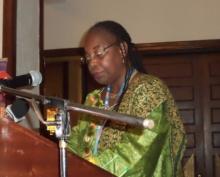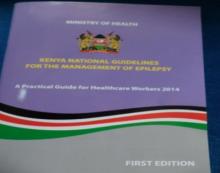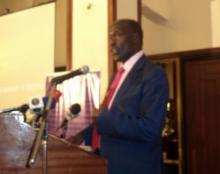Kenya National Guidelines for the management of epilepsy launched
26 March 2014, Nairobi – Today makes another historical day in Kenya by the launch of the National Guidelines for the Management of Epilepsy. The event was graced by Ministry of Health Principle Secretary Prof. Fred Segor and attended by other dignitaries including the WHO Country Representative Dr Custodia Mandlhate.
In his address to the nation, Prof. Segor said that the launch of the guidelines for management of epilepsy was very timely as the country will use this opportunity to demystify epilepsy. He noted that statics in Kenya indicate that the prevalence of epilepsy is 18.6/100,000 of population.
Prof. Segor said his ministry will focus on person-centred care and that being a treatable condition; the ministry will aim to reduce the treatment gap by making medicines available and scaling up advocacy and awareness creation activities. The PS added that factual information on epilepsy must be disseminated to all in the country in order to demystify epilepsy. He noted that the guidelines provided step by step treatment care to health professionals of all cadres. He urged all to embrace a multi-sectorial approach in management of epilepsy noting that psychosocial support was very important.
Prof. Segor also stressed on the importance of prevention of secondary causes and promotion of good health services especially during ante-natal care and during child birth. He said prevention of violence and trauma will also reduce cases of secondary epilepsy.
In her remarks as the WHO Country Representative, Dr. Custodia Mandlhate congratulated the nationals for having developed yet another very important document where many shy from. She said this is yet another indication that indeed the country has shown high level commitment in addressing NCDs.
Dr Custodia reminded all that we must talk about epilepsy which is one of the non-communicable disorders of the brain as talking about it reduces the stigma it has carried for centuries. The WHO Country Representative said that epidemiological global figures indicate that around 50 million people worldwide have epilepsy and that 80% of these are found in developing regions. The good thing she noted is that 70% of epilepsy cases can respond well to treatment and can be controlled, but unfortunately yet the majority, about three fourths, of affected people in developing countries do not get the treatment they need. Stigma and discrimination is another impediment to accessing treatment in many parts of the world she said.
Dr, Custodia reiterated that epilepsy imposes an enormous physical, psychological, social and economic burden on individuals, families and countries, especially due to misconceptions, fear and stigma. Many people with epilepsy suffer in silence, as they remain socially isolated for fear of possible hostile reactions of others not affected by epilepsy, and do not come forward for treatment.
Epilepsy is, however, one neurological disorder for which cost-effective treatments are available. She reiterated that World Health Organization places epilepsy as a major public health concern in many African countries and urged the country to provide better information and raise awareness about epilepsy, and strengthen public and private efforts to improve prevention, treatment and care and reduce the negative impact of the disease.
She commended the development of the management guidelines which if widely disseminated and appropriately used, will immensely contribute to the reduction of the epilepsy treatment gap. Through awareness to the communities, stigma will be reduced and advocate for good health seeking behaviours is mandatory, she concluded.
Others who spoke at the function included the Chairman of Kenya Society of Epilepsy, Prof. Paul Kioy who gave a brief history of how the guidelines were developed and reiterated that with the guidelines provided a standardized management of epilepsy in the country. He said that through these guidelines, patients will be empowered to self-manage their condition.
He concluded by saying that the guidelines are a beginning of sunset ignorance and stigma associated with epilepsy.
Testimonies of 3 persons living with epilepsy were shared, including that of the Chairman of Kenya Association for Welfare of people living with Epilepsy (KAWE) Dr. Miyanji. Remarks from other senior health officials including, the Head of the Directorate of Preventive and Promotive Health Services Dr. William Maina and the Nairobi County Health Director Dr. Samuel Ochola were also made.







